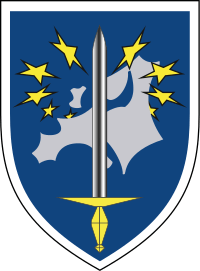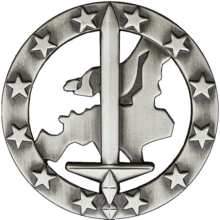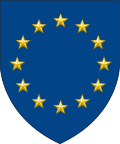Eurocorps
The European Corps (Eurocorps) is an intergovernmental military corps with its headquarters of approximately 1,000 soldiers stationed in Strasbourg, Alsace, France. The corps had its headquarters established in May 1992, activated in October 1993 and declared operational in 1995. The nucleus of the force is the Franco-German Brigade established in 1987.[1] The Treaty of Strasbourg, signed in 2004, gave the corps its formal legal basis when it entered into force on 26 February 2009.[2]
| European Corps | |
|---|---|
 | |
| Active | 1993–present |
| Country | |
| Allegiance | |
| Branch | Army |
| Type | Multinational military Corps headquarters |
| Size | 1,000 troops in HQ plus 6,000 troops in the Franco-German Brigade (although the number may change in relation to specific military operations) up to 60,000 troops in total |
| Garrison/HQ | HQ Strasbourg Multinational Command Support Brigade – Strasbourg Multiple earmarked units of framework nations |
| Engagements | European Union Training Mission in Mali (2015) European Union Training Mission in the Central African Republic (2016-2017) |
| Commanders | |
| Eurocorps Commander | Lieutenant General Jürgen Weigt |
| Deputy Commander | Major General Pierre Gérard |
| Chief of Staff | Major General Fernando García Blázquez |
The European Corps is presently not established at the EU level (referred to as the Common Security and Defence Policy, CSDP); it is for instance not a project of the Permanent Structured Cooperation (PESCO) of the CSDP. The European Corps and its assets may however contribute in the implementation of the CSDP, when made available as a multinational force in accordance with article 42.3 of the Treaty on European Union (TEU).
Participating countries
Five countries participate in the corps as member nations.[3] The treaty allows for any EU member state to become a Eurocorps member state, subject to the approval of existing Eurocorps members.[2]
Additionally, four states are associated, and have thus pledged to contribute personnel to the staff.[3][4] Poland was accepted as a member in 2010. This was expected to become effective from 1 January 2016,[3] but was delayed to January 2017.[5] However, a change in government with the 2015 Polish election led to the application for full membership being withdrawn in favour of remaining an associate member.[6] On 25 February 2003, Austria and Finland signed a treaty which allowed them to send staff to the headquarters of the corps.[7] Finland remained an associated nation of the corps until 2005, and Austria until 2011.[3] Romania became an associated nation in April 2016.[8][9] In addition, the Netherlands and United Kingdom have sent liaison officers to the headquarters of the corps.[7][10]
.svg.png)




Associated nations:[3]
Former associated nations:[3]
Organisation
The European Corps is not subordinate to any other military organisation.[1] It is deployed on the authority of the Common Committee representing the member nations,[12][13] the Chief of Defense, and the Political Director of the Ministry of Foreign Affairs. This committee considers requests for support from multinational organizations such as the UN, NATO, OSCE or EU. The Corps can also be deployed at the request of the framework nations.
Command structure
The headquarters of the corps is based in Strasbourg near the Franco-German border, the seat of several European institutions. The headquarters contains the following units:[14]
- Command Group, based in Quartier Aubert de Vincelles, consisting of the Commanding General, the Deputy Commanding General, the Chief of Staff, the Deputies Chief of Staff, the Air and Navy representatives, the legal advisers, a public affairs office, a medical adviser and a political adviser (only during engagement).
- Staff of approximately 350 providing support to the command group. The staff also includes officers from Poland, Greece, Italy, Turkey and Romania.
- Multi-national Command Support Brigade is co-located in Strasbourg (Quartier Aubert de Vincelles). This brigade is separate and subordinate to the Corps headquarters and provides additional support when the Corps is deployed. The brigade is formed from units provided by the nations on a case-by-case basis but has a permanent headquarters of 80 personnel.
- Headquarters Support Battalion (subordinated to the multi-national Command Support Brigade), based in Strasbourg (Quartier Lizé), providing protection, transport, food, etc. to the headquarters. This battalion consists of approximately 500 soldiers but can be significantly reinforced in case of commitments.
German and French were the official languages at the corps until August 2002. English is now the working language.[15]
Subordinate units
Operational Command
The Franco-German Brigade, with 6,000 troops, is the only military formation permanently under the operational command of corps. The brigade is stationed in Müllheim, Donaueschingen, Immendingen, Sigmaringen, Meßstetten, Stetten am kalten Markt, Villingen-Schwenningen in Germany and Illkirch-Grafenstaden in France.[16] Additional affiliated formations could be placed under command of the corps headquarters for specific operations, for example in support of EU or NATO rapid-response missions.[17] The five framework countries have earmarked the following units and formations to the corps:
Affiliated units and formations
In addition to the Franco-German Brigade, a number of nations have earmarked units or formations that they have affiliated to the corps HQ. These do not come under the permanent command of corps but rather can be provided to the corps for specific operations. For example,
- French Contribution
- A division-size unit, from 1993 to 1999 it was the 1re Division Blindée (HQ in Baden-Baden, Germany)
- German Contribution
- A division-size unit like the 10th Armored Division with its HQ in Veitshöchheim
- Belgian Contribution
- The 1st Medium Brigade, stationed in Leopoldsburg
- Spanish Contribution
- The "Cuartel General del Mando de Fuerzas Pesadas" (Heavy Forces Command) in Burgos where the 1st Mechanized Division is stationed.
- Luxembourg Contribution
- A reconnaissance company (180 soldiers) based in Diekirch, composed of two reconnaissance platoons, an anti-tank platoon and a logistics support element. This unit will probably be integrated into the Belgian contribution during operations.
Except for the Franco-German Brigade and the staff of the Multinational Command Support Brigade (MNCS Bde) who are permanently under operational command of the headquarters, these national contributions remain under national command in peacetime. They can become fully subordinated only after Transfer of Authority has been decided by member states.
The size and type of corps units required in operations depends on the nature and scope of assigned missions, likely deployment and the expected operational outcome. In the case that all earmarked national contributions are committed, the corps would theoretically comprise approximately 60,000 troops.

Operations
The corps has:
- Participated in peacekeeping missions in Bosnia
- Led KFOR III in Kosovo from 18 April 2000 to October 2000
- Led the ISAF6 Force in Afghanistan from 9 August 2004 to 11 February 2005.[18]
- From 1 July 2006, to 10 January 2007, the headquarters of the corps was the land component stand by element of the NATO Response Force 7.
- From 1 July 2010 to 10 January 2011, the headquarters of the corps was the land component stand by element of the NATO Response Force 15 (NRF 15).
- In 2012, the corps has deployed to ISAF in Afghanistan.
- In the second semester the Eurocorps is supporting Germany with 57 soldiers in the EU mission EUTM Mali.
Relationship with EU defence policy
The European Corps is presently not established at the EU level (referred to as the Common Security and Defence Policy, CSDP); it is for instance not a project of the Permanent Structured Cooperation (PESCO) of the CSDP. The European Corps and its assets may however contribute in the implementation of the CSDP, when made available as a multinational force in accordance with article 42.3 of the Treaty on European Union (TEU).
See also
- Combined Joint Expeditionary Force (CJEF)
- European Institutions in Strasbourg
- Franco-British Defence and Security Cooperation Treaty and Downing Street Declaration
- EUFOR
- European Gendarmerie Force
- European Maritime Force
- European Astronaut Corps
- EU Battlegroup
- Common Security and Defence Policy
- Common Security and Defence Policy#Current content and structure
- European Security Strategy
- European Defense Agency
- Overseas interventions of the European Union
Notes
- The corps is made avalilable to the Common Security and Defence Policy in accordance with TEU, Article 42.3.
References
- "Eurocorps' official website / History". Retrieved 23 February 2008.
- "Treaties and international agreements registered or filed and recorded with the Secretariat of the United Nations" (PDF). United Nations. 2009. Retrieved 23 May 2018.
- "Participation". Eurocorps. Retrieved 18 February 2014.
- Comp. Domröse, Hans-Lothar 2011: „Zwei Jahre Kommandierender General des Eurokorps. Eine persönliche Bilanz." In: Europäische Sicherheit Nr. 10/2011, p. 13–16.
- "Eurocorps - A Military Tool for Europe and NATO" (PDF). Instituto Español de Estudios Estratégicos. 13 April 2016. Retrieved 14 April 2016.
- "Poland to withdraw troops from Eurocorps force: official". Agence France-Presse. 28 March 2017. Retrieved 28 March 2017.
- "Eurokorps begrüßt Österreich und Finnland". Austrian Armed Forces. 25 February 2003. Retrieved 25 February 2014.
- "Aderarea României la Eurocorp". 6 April 2016. Retrieved 17 March 2018.
- "Romania joins Headquarters Eurocorps". Eurocorps. 7 April 2015. Retrieved 15 April 2016.
- "Going International: Das Eurokorps - ein Schritt nach Europa". Austrian Armed Forces. 25 February 2003. Retrieved 25 February 2014.
- "TRA20040219". Ministry of Europe and Foreign Affairs. Retrieved 23 May 2018.
- Belgium, France, Germany, Luxemburg and Spain
- "The Common Committee on Eurocorps' official website". Archived from the original on 5 February 2008. Retrieved 23 February 2008.
- p. 894, Kleine, Maxim, Integrated Bi- and Multinational Military Units in Europe, in: Georg Nolte (Editor), European Military Law Systems, Walter de Gruyter, 2003.
- Directive No. 2 pour le Général commandant le Corps européen from 14 November 1994: Langues au Corps européen.
- "History of the Franco-German Brigade (in German)". Archived from the original on 12 December 2007. Retrieved 23 February 2008.
- France-USA Archived 9 December 2007 at the Wayback Machine.
- "International Security Assistance Force - ISAF VI on Eurocorps' official website". Archived from the original on 12 January 2008. Retrieved 23 February 2008.
External links
| Wikimedia Commons has media related to Eurocorps. |

